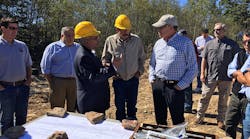Coal By-Products Could Help Drive Sustainable U.S. Rare Earth Production
Physical separation technologies newly developed at Purdue University are among several recent initiatives that could yield economical methods for extracting rare earth elements (REEs) essential to electronics manufacturers from coal by-products.
If commercially viable, the innovations could help enable the U.S. to reclaim part of the $4 billion REE production market that has largely been ceded to China over the past two decades. Additionally, they would provide an environmentally friendly method for recycling a portion of the 129 million tons of coal ash the U.S. produces each year.
“REEs have many important applications in things such as permanent magnets in power generation and electric cars, batteries, petroleum-refining catalysts, phosphors in color televisions, and many electronics, including cellphones," says Purdue Professor of Chemical Engineering Linda Wang, who has pioneered chromatography separation techniques to isolate REEs from other impurities and from each other. The new processes use inexpensive titania sorbents that can effectively separate REEs with purities and yields greater than 95%.
Wang says that the U.S. has accumulated 1.5 billion tons of REE-rich coal ash, a by-product of the burning of coal in power plants to generate electricity, which could be used to produce REEs for decades. Purdue's Office of Technology Commercialization has patented Wang's technology, which is now available for license.
National Security Concerns Over Lack of Domestic Production
For much of the second half of the 20th century, the U.S. dominated global production of REEs—a group of 15 lanthanide metals plus scandium and yttrium that, due to their chemical properties, are widely used in electronics and other high-tech products. However, competition from lower-cost Chinese mines, combined with increased U.S. production costs and regulatory requirements, led to the closure in 2002 of California's Mountain Pass mine, which at one time had supplied one-third of world demand for REEs.
The vast majority of the approximately 17,000 tons of rare earth used each year in the U.S. is now imported from China, which controls over 90% of the global supply. China's near monopoly over REE supply has implications beyond consumer electronics manufacturing, as these elements are also critical to building components for industries, such as military/defense, that are vital to national security.
According to Wang, after China reduced export quotas for REEs in 2010, the costs of rare earth magnets for one wind turbine increased from $80,000 to $500,000. Following the easing of export restrictions 18 months later, prices dropped below their 2010 levels.
"It’s highly desirable to develop the capacity to produce REEs in the U.S. and to become independent of foreign suppliers,” she says.
New Technologies to Compete for Rare Earth Metals
Future Market Insights projects that the global market for REEs, currently valued at $3.3 billion, will increase at a compound annual growth rate of 8.5% over the next decade, reaching $7.4 billion by 2026. Products such as smartphones, tablets, and laptop computers will face increasing competition for REEs from high-growth applications such as electric vehicles and renewable energy technologies.
However, even with growing market demand and upward price pressure on REEs, restarting domestic mine production is unlikely. Because REEs occur in ores in very small concentrations—a few thousand parts per million—extensive mining, grinding, extraction, and purification processes are required to transform the ores to the very high purities required for commercial applications.
Conventional separation technologies produce a large amount of chemical waste that cannot be effectively recycled. Perhaps the most notorious evidence of this is the Baogang Tailings Dam, a four-square-mile lake containing over 10 million tons of toxic sludge that is the residue of REE production and processing at Baotou Steel, the world's largest producer of rare earth minerals.
DOE Funds Research into Sustainable REE Production
Recent U.S. activities to ramp up rare earth production have instead focused on more environmentally benign methods for producing REEs. In 2014, the U.S. Department of Energy (DOE) launched its REE program to address the feasibility of separating and extracting REEs from coal and coal by-products. Among the projects the agency is currently funding are:
- A $1 million project involving Penn State University and the Jeddco Coal Company, among others, that will use a chemical process known as ion exchange to isolate and extract REEs from anthracite coal.
- An $875,000 partnership between Battelle Memorial Institute and materials technology company Rare Earth Salts to produce rare earth oxides by selectively leaching them from coal fly ash.
Separately, the DOE is helping fund research to recover and recycle REEs directly from electronic products. In 2016, the agency's Oak Ridge National Laboratory partnered with Oddello Industries to test a method for recycling hard drives that employs a system to sort and align them on a conveyer for processing. The testing uses two methods—ultra-high-speed fastener removal and punching—and aims to demonstrate cost-effective recovery of rare earth magnets, their permalloy brackets, circuit boards, aluminum, and steel.
The DOE is also providing support for development of a technology devised at the University of Pennsylvania that uses a newly developed organic compound to separate mixtures of RE metals—with the goal of demonstrating its ability to cost-effectively extract REEs from consumer products for recycling.









